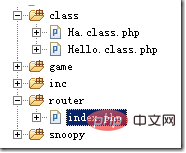URLルーティング分散機能をphpで実装する方法
- coldplay.xixiオリジナル
- 2020-08-29 14:02:002608ブラウズ
PHP が URL ルート配布機能を実装する方法: まず、サーバー構成内の [/router/] パスをインターセプトし、次にルート ディストリビュータを実装して要求された URI を取得し、最後にモジュールを作成します。

[関連する学習の推奨事項: php グラフィック チュートリアル]
URL ルーティング分散関数を PHP で実装する方法:
最初のステップは、サーバー構成で /router/ を構成することです。

特定のフォルダー ディレクトリにある index.php ページをインターセプトするには、すべてのモジュールが個別の次の図に示すように、ファイルはルーターと同じレベルにあるクラス ディレクトリに保存されます。

#2 番目のステップはルーティングの実装です。 distributor (index.php)
<!Doctype html>
<html>
<head>
<title>路由测试~~</title>
<meta http-equiv="content-type" content="text/html; charset=utf-8" />
</head>
<body>
<?php
date_default_timezone_set("Asia/Shanghai");
define("MODULE_DIR", "../class/");
$_DocumentPath = $_SERVER['DOCUMENT_ROOT'];
$_FilePath = __FILE__;
$_RequestUri = $_SERVER['REQUEST_URI'];
$_AppPath = str_replace($_DocumentPath, '', $_FilePath); //==>\router\index.php
$_UrlPath = $_RequestUri; //==>/router/hello/router/a/b/c/d/abc/index.html?id=3&url=http:
$_AppPathArr = explode(DIRECTORY_SEPARATOR, $_AppPath);
/**
* http://192.168.0.33/router/hello/router/a/b/c/d/abc/index.html?id=3&url=http:
*
* /hello/router/a/b/c/d/abc/index.html?id=3&url=http:
*/
for ($i = 0; $i < count($_AppPathArr); $i++) {
$p = $_AppPathArr[$i];
if ($p) {
$_UrlPath = preg_replace('/^\/'.$p.'\//', '/', $_UrlPath, 1);
}
}
$_UrlPath = preg_replace('/^\//', '', $_UrlPath, 1);
$_AppPathArr = explode("/", $_UrlPath);
$_AppPathArr_Count = count($_AppPathArr);
$arr_url = array(
'controller' => 'index',
'method' => 'index',
'parms' => array()
);
$arr_url['controller'] = $_AppPathArr[0];
$arr_url['method'] = $_AppPathArr[1];
if ($_AppPathArr_Count > 2 and $_AppPathArr_Count % 2 != 0) {
die('参数错误');
} else {
for ($i = 2; $i < $_AppPathArr_Count; $i += 2) {
$arr_temp_hash = array(strtolower($_AppPathArr[$i])=>$_AppPathArr[$i + 1]);
$arr_url['parms'] = array_merge($arr_url['parms'], $arr_temp_hash);
}
}
$module_name = $arr_url['controller'];
$module_file = MODULE_DIR.$module_name.'.class.php';
$method_name = $arr_url['method'];
if (file_exists($module_file)) {
include $module_file;
$obj_module = new $module_name();
if (!method_exists($obj_module, $method_name)) {
die("要调用的方法不存在");
} else {
if (is_callable(array($obj_module, $method_name))) {
$obj_module -> $method_name($module_name, $arr_url['parms']);
$obj_module -> printResult();
}
}
} else {
die("定义的模块不存在");
}
?>
</body>
</html>リクエストされた URI を取得し、ロードするモジュール名と呼び出しメソッド名を取得し、URI パラメータで簡単に判断します。..
3 番目のステップ、モジュールの書き込み
##上記の URI によると、呼び出したいのは Hello モジュールの下のルーター メソッドであり、Hello.class.php という名前のファイルを定義できます。クラスディレクトリ内 (Linux では大文字と小文字が区別されることに注意してください)<?php
class Hello {
private $_name;
private $_varValue;
function __construct() {
}
function router() {
$this->_name = func_get_arg(0);
$this->_varValue = func_get_arg(1);
}
function printResult() {
echo $this->_name;
echo "<p>";
echo var_dump($this->_varValue);
echo "</p>";
}
}
?>同様に、Ha モジュールを書くことができます。..関連学習の推奨事項:php プログラミング (ビデオ)
以上がURLルーティング分散機能をphpで実装する方法の詳細内容です。詳細については、PHP 中国語 Web サイトの他の関連記事を参照してください。
声明:
この記事の内容はネチズンが自主的に寄稿したものであり、著作権は原著者に帰属します。このサイトは、それに相当する法的責任を負いません。盗作または侵害の疑いのあるコンテンツを見つけた場合は、admin@php.cn までご連絡ください。

